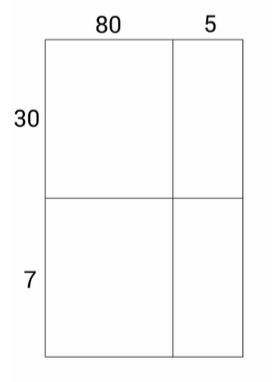Simple Strategy to Teach Multi-Digit Multiplication
Your student is sitting at the dining room table. He’s supposed to be doing his math assignment. Instead, he’s doodling his hate for the subject in the margins.
He’s already tried multiplying 52×28 but keeps getting the wrong answer.
You’ve tried explaining it. Multiple times. But to no avail. He has given up and you’re about ready to join him. You start thinking, maybe it’s not that important. Maybe I should just get out the calculator.
Before you give up, try showing your student this simple strategy for multi-digit multiplication. Show him how to multiply in a way that has meaning.
Try using an area model. I’ll show you how.

*Please Note: Some of the links in this post are affiliate links and help support the work of this site. Read our full disclosure here.*
Using an Area Model to Teach Double Digit Multiplication:
One of the most common mistakes teachers make is going too quickly into the abstract, which is probably why your student is stuck.
So, let’s go back a step and show what multi-digit multiplication means.
I’m going to create a story around my model. I do this every time I teach a student a new concept. Having a story gives students something to visualize, something concrete to hold onto when they get confused.
Here’s my story:
“There is a playroom that is split into four sections. The carpet is old and yucky. Not safe for children to play on. So, we are going to rip out the old carpet and put some beautiful new carpet in. But it’s a playroom, so we can’t just do one kind of carpet. Each section will have its own colored carpet. How much carpet do we need for each section? Here is a picture of the playroom:

The story you tell isn’t super important. Pick something you think your student would be interested in.
As you can tell from my drawing, accuracy isn’t super important either. Although with younger students it might matter more than older.
The point is to be able to visualize all of the steps that need to be taken to solve the problem 52 x 28.
Once we have solved the area of each section, our picture will look like this:

Next we ask our student:
How much carpet do we need for the whole room?
Add up all of the areas of each rectangle.
1000+400+40+16=1,456
So easy!
Let’s set up another one to make sure you’ve got it down.
Setting Up the Area Model for Multi-Digit Multiplication:
Let’s say you want to solve the problem 85 x 37. When I first teach students how to use this model, I have them split the numbers using expanded form. In this case, each number would be split into 10’s and 1’s. So we need a rectangle split once horizontally, and once vertically.
Next step is to label each section. I’m going to put 85 across the top and 37 down the side. I could also have put 37 across the top and 85 down the side. Either will get you the same answer (commutative property of multiplication ;)).
If we add the numbers across the top (the length of the room) we get 80 +5 = 85. And the side is 30 +7 = 37
And since we are multiplying the numbers together (or finding the area of the room) it looks like:

(80 + 5) x (30+7) or 85 x 37
Now we find the area of each section.

Once your student gets comfortable with this model, the story behind it won’t be necessary. In fact, they may be able to solve problems without it altogether.
Next, let’s look at multiplying bigger numbers.
Using the Area Model for Triple Digits and Beyond:
The area model is so flexible you can use it with any size numbers you want. If you were multiplying 542 and 23, your box would have three sections by two sections.
Multiplying 765 by 765 would have three sections by three sections and have nine problems to solve.

Get Your Free Printable!
Want a simple printable version to use with multiplication problems over and over? Download the printable below. Then laminate it and enjoy tear free multiplication. 🙂
Don’t give up, you can do this!

{Click HERE to download the handy dandy multi-digit multiplication printable!}
Looking for other math teaching tips? Check out these articles:
Danielle is a homeschooling mamma of 5. She is committed to making life with young children easier and sharing her passion for math. If you would like to learn more about teaching math to multiple age groups visit Blessedly Busy or follow her on: Facebook, Instagram, Pinterest, or Twitter.












This is an excellent strategy! I did it before and it was very useful for those who really battled.
I love this idea of teaching multiplication! Thank you so much! Where have you been all my life? LOL Thanks again!